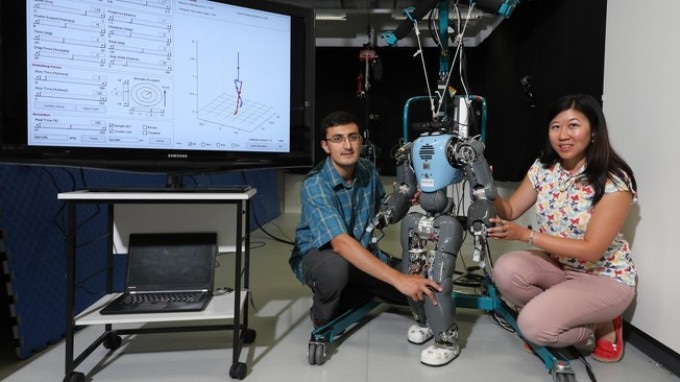Aug 27 2018
EPFL’s newly designed avatar-based software examines how people walk so as to predict their energy expenditure. The software, initially meant for roboticists and for scientists who develop exoskeletons and prosthetics, could have many uses in both sports and medicine. It can be tested online via a downloadable app.
 Image credit: Salman Faraji and Amy Wu © Alain Herzog / 2018 EPFL
Image credit: Salman Faraji and Amy Wu © Alain Herzog / 2018 EPFL
Humans inherently adopt the gait that requires the minimum amount of energy given the walking circumstances. Without consciously thinking about it, people continuously alter stride length, pace, and foot lift. But would it be possible to intentionally play with these parameters so as to impact one’s energy expenditure?
Scientists at EPFL’s Biorobotics Laboratory from the School of Engineering examined eight gait parameters so as to find a very sophisticated software program that uses an avatar to predict how much energy people utilize when they walk based on their walking style. This study has been published in Scientific Reports. Salman Faraji, the co-lead author, dedicated a whole section of his thesis to this area; his public defense will happen on August 24th.
The avatar - a torso fitted with two legs with feet - can be easily configured. Users begin by keying in their weight and height and can then fix the walking speed, distance between their feet (stride width and stride length), and foot lift, to with the incline of both the torso and the ground. They can also include mass and mimic the effect of being pushed or pulled at various parts of the body. The number of calories burned and the energy consumption are shown in real time whenever the parameters are altered.
Making Custom Exoskeletons
This pioneering software drew on many experiments appearing in latest literature, and it offers a vast number of probable applications - particularly in the medical realm.
“The software could be used to select the best design for an exoskeleton or a custom prosthetic, in order to reduce the user's effort. With a wearable exoskeleton, for example, we could optimize the location of the battery and actuators, or determine the ideal walking pattern for the user’s preferred speed,” says Amy Wu, the study’s other co-lead author. The software could even establish where a backpack should be worn so as to reduce energy expenditure. “If, on the other hand, your goal is to burn calories, the software could be used to find a series of movements with a high metabolic cost.”
Designed for Humanoid Robots
The software was designed in a robotics lab and was primarily meant to study the mechanics of human gait for application in humanoid robots. “The way humans walk is extremely complex. The level of control required is a huge challenge for humanoid robots, which often don’t get it quite right,” says Faraji. “We have a long way to go before we really understand all the parameters that go into human, animal and robot locomotion.”
An avatar uses your gait to predict how many calories you will burn
References: Salman Faraji, Amy R. Wu & Auke J. Ijspeert, A simple model of mechanical effects to estimate metabolic cost of human walking, Scientific Reports